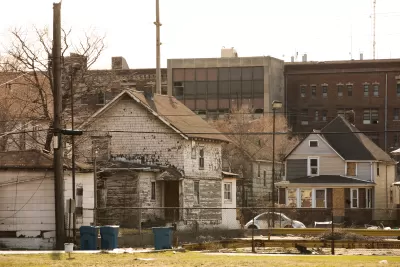As more evidence shows that neighborhood-level factors heavily impact future outcomes, place-based policies should use more accurate measurements to ensure persistently poor places don’t fall through the cracks.

A commentary in Route Fifty by August Benzow and Kenan Fikri describes how new research explains “how an economically distressed place can transmit poverty from one generation to the next.”
For the authors; it is important to point out that “Pioneering researchers like Harvard’s Raj Chetty have shown that children who grow up in high-poverty environments are less likely to climb the income ladder as adults,” contrary to the popular American narrative of bootstrap success.
For Benzow and Fikri, “the way we measure and target persistent poverty leaves millions of vulnerable Americans invisible to programs intended to support them.” This includes how places are designated as ‘chronically poor,’ which is currently done at the county level. “Looking no deeper severely underestimates the size of the problem and therefore the scope of the challenge. Roughly 20.5 million Americans live in a persistent-poverty county, but 35 million reside in a persistent-poverty census tract.”
The article concludes that “high poverty rates will persist across thousands of American communities because the fabric that weaves them into the national economy has grown threadbare.” The authors call for “a growth agenda for persistent-poverty communities—the very places where the nation’s social and economic challenges are greatest.”
FULL STORY: Will the new wave of place-based policy leave persistently poor areas behind?

Alabama: Trump Terminates Settlements for Black Communities Harmed By Raw Sewage
Trump deemed the landmark civil rights agreement “illegal DEI and environmental justice policy.”

Planetizen Federal Action Tracker
A weekly monitor of how Trump’s orders and actions are impacting planners and planning in America.

Why Should We Subsidize Public Transportation?
Many public transit agencies face financial stress due to rising costs, declining fare revenue, and declining subsidies. Transit advocates must provide a strong business case for increasing public transit funding.

Understanding Road Diets
An explainer from Momentum highlights the advantages of reducing vehicle lanes in favor of more bike, transit, and pedestrian infrastructure.

New California Law Regulates Warehouse Pollution
A new law tightens building and emissions regulations for large distribution warehouses to mitigate air pollution and traffic in surrounding communities.

Phoenix Announces Opening Date for Light Rail Extension
The South Central extension will connect South Phoenix to downtown and other major hubs starting on June 7.
Urban Design for Planners 1: Software Tools
This six-course series explores essential urban design concepts using open source software and equips planners with the tools they need to participate fully in the urban design process.
Planning for Universal Design
Learn the tools for implementing Universal Design in planning regulations.
Caltrans
Smith Gee Studio
Institute for Housing and Urban Development Studies (IHS)
City of Grandview
Harvard GSD Executive Education
Toledo-Lucas County Plan Commissions
Salt Lake City
NYU Wagner Graduate School of Public Service





























